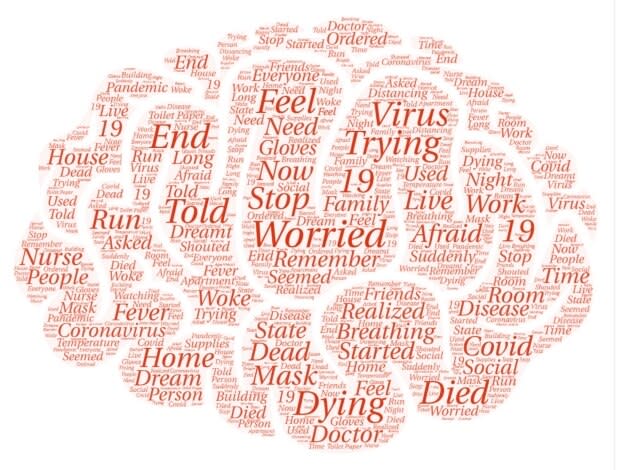Bugs, crowds and celebrities: why it's worth paying attention to our pandemic dreams
Earlier this week, Tim Schutz found himself running through the residential streets of west Edmonton naked — in his dream, that is.
The dream was so bizarre he tweeted about it and kept thinking about it for several days.
In another recent vivid dream, he was being confined to one room. When he asked to leave, he was told to sit down and relax.
After waking up from that dream, the longtime Edmonton resident recalled feeling tired and frustrated.
"It felt like I was running a marathon," he said.
Strange dreams are not unusual for Schutz, but they have intensified in recent weeks, and researchers say thousands of people around the world are noticing the same thing.
"We're remembering more dreams than usual, and those dreams are especially vivid and bizarre," writes Harvard researcher Deirdre Barrett in her new book, Pandemic Dreams. Her book draws on thousands of dreams submitted to an online survey she launched in late March.
From the submissions, clusters of similar themes and images have emerged, such as fears of catching the virus. Metaphorical representations of the virus have also been common, with many people recounting dreams about swarms of bugs.
"Our dreaming mind is so visual that when it's feeling scared, it searches for an image that matches that," Barrett told CBC News in an interview this week.

People have reported dreams of celebrities, political leaders, monsters, being in prison and, in some cases, finding a cure or detection method for COVID-19.
Canadian researchers are also studying the patterns in our pandemic dreams.
Tore Nielsen, a professor in the Université de Montréal's department of psychiatry and the director of the Dream and Nightmare Laboratory, is using text-mining techniques to analyze thousands of tweets about pandemic dreams.
Like Barrett, he has been collecting dreams via an online survey, and he and a student are working on a qualitative analysis of the emotions expressed in pandemic dreams.
Zombies and other creatures have shown up in his samples too, but the most common theme he has observed is social distancing.
"Being in crowds, in enclosed places, being surrounded by people who are not social distancing, or interacting with people and suddenly realizing that you're not social distancing," Nielsen said.
Reports are coming in from health-care workers and from COVID-19 survivors who have reported dreadful nightmares.
"They can spend weeks in a state of half-hallucination, half-dream where they think that the doctors are trying to poison them," Nielsen said.
While dreams may be reflecting fears and trauma related to COVID-19, Don Kuiken, a professor emeritus of psychology at the University of Alberta, has a hunch that many dreams are reflecting a different theme: loss.
"The pandemic seems to me to be different because it touches so directly on sources of pain that are related to loss," Kuiken said, "and that means that experiences with bereavement may be more likely to be recalled or to influence a person's dreams than other traumatic events, as in the case of nightmares."
What's driving these vivid dreams?
Experts say changing sleep habits is likely a big reason why people are reporting more vivid dreams during the pandemic.
"During the pandemic, chances are that if you are working from home and you don't have three or four kids to keep you up, you are getting better sleep, and when you get better sleep you get more vivid dreams," said Pearl Gregor, who leads dream analysis workshops in Edmonton.
Most dreams occur during REM (rapid eye movement) sleep phases, which tend to become longer throughout the night. So cutting back on sleep results in losing longer dream-rich periods.
In addition, Barrett said, traumatic crises tend to stir up our dream lives.
Researchers who examined Americans' dreams before and after 9/11, for example, concluded that the dreams after the attacks contained more intense imagery.
What can we learn from pandemic dreams?
In the coming months, researchers like Barrett and Nielsen plan to study the frequency of certain words and themes in pandemic dreams in greater depth. They will also be examining how dreams have changed over the course of the pandemic and how they differ geographically. Nielsen's survey asks people to report certain memories and experiences that could be connected to their dreams.
"Part of what we're looking for is the memory sources and how our memory is transformed into dreams," he said.
"Ultimately, if we can put the two together — the sources and the dream work that's being done — then we may have something really useful."
Experts say studying dreams can also be valuable and therapeutic on an individual level.
Symbols in dreams may come from people's day-to-day lives, but they can also connect to themes and ideas others have grappled with.
That's why Joel Crichton, an Edmonton-based analytic psychotherapist, encourages people to write down their dreams and think about what they might mean.
"It grounds you to see that wow, what I'm living through is uniquely mine and it's also joined with something that people have been living through throughout history and is in some way happening everywhere, all the time," Crichton said.

